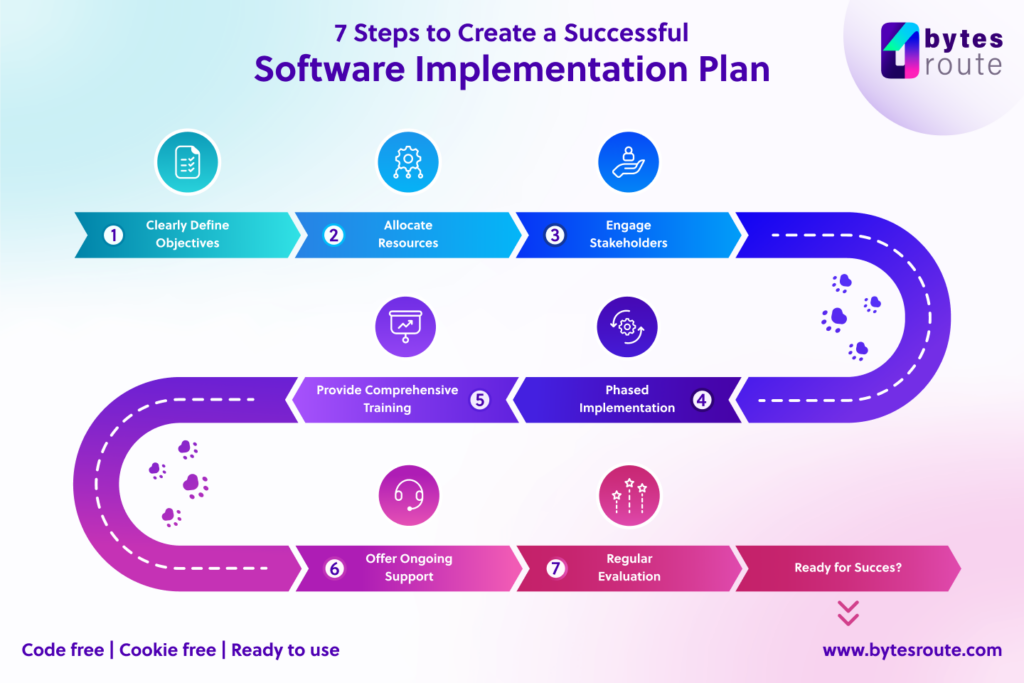After picking your software and choosing your implementation team, you should create a strategy that will ensure everything goes smoothly and increase the return on your investments.
The digital adoption sector has witnessed significant growth as businesses increasingly embrace technology for enhanced efficiency and customer experiences. As companies delve into software implementation, understanding essential terminologies becomes crucial for success.
In this article, we present a comprehensive glossary of commonly used terms in the digital adoption industry. We’ll explore what software implementation is and how to integrate it in your digital adoption process.
1. What is Digital Adoption
Digital adoption refers to the process of integrating digital tools into an organization’s workflows to maximize their benefits. It involves ensuring that employees effectively use these tools to achieve their objectives, resulting in improved productivity and performance.
2. What is Digital Adoption Manager
A Digital Adoption Manager is a specialized role responsible for overseeing the successful adoption of new digital tools within an organization. This manager provides guidance, training, and support to employees during the implementation phase to ensure a smooth transition and effective utilization of the software.
3. What is Software Implementation
Software implementation is the process of installing, configuring, and making a new software system operational within an organization. It involves various stages, such as planning, testing, deployment, and post-implementation support, to ensure a seamless integration of the software into the existing infrastructure.
4. Software Implementation Process
The software implementation process comprises a series of steps and actions that need to be followed to achieve successful adoption. It typically includes:
- Planning: Defining the goals, objectives, and requirements of the software implementation. This phase also involves identifying potential challenges and creating a roadmap for the process.
- Selection of the Right Software: Carefully evaluating and selecting the software that best aligns with the organization’s needs and objectives.
- Team Formation: Assembling a skilled and dedicated team to manage the implementation process, including representatives from various departments who will be impacted by the software.
- Configuration and Customization: Tailoring the software to meet specific organizational needs and integrating it with existing systems.
- Testing: Conducting thorough testing to identify and resolve any issues before full deployment.
- Training: Providing comprehensive training to employees to ensure they understand the software’s functionalities and can use it effectively.
- Deployment: Gradually rolling out the software across the organization, ensuring proper support and assistance during the transition.
- Monitoring and Feedback: Continuously monitoring the software’s performance and gathering feedback from users to make necessary improvements.
5. Software Implementation Plan
A software implementation plan is a detailed roadmap that outlines the entire implementation process, including objectives, timelines, resources, responsibilities, and potential risks. It acts as a guide for the implementation team, ensuring a structured and well-coordinated approach.

Why is Software Implementation Important?
Software implementation is vital for organizations seeking to enhance productivity, efficiency, and competitiveness. It empowers businesses to leverage the full potential of digital tools, streamline processes, and optimize decision-making. Successful software implementation results in:
- Improved Efficiency: Automated processes and streamlined workflows lead to enhanced efficiency and reduced manual errors.
- Enhanced Customer Experience: With digital tools in place, businesses can provide better customer service and meet their demands more effectively.
- Data-Driven Insights: Digital adoption enables organizations to collect and analyze data for informed decision-making and identifying growth opportunities.
How to Create a Successful Software Implementation Plan
Creating a successful software implementation plan involves the following steps and strategies:
- Clearly Define Objectives: Establish specific, measurable, achievable, relevant, and time-bound (SMART) objectives for the implementation process.
- Allocate Resources: Ensure adequate resources, including budget, skilled personnel, and time, are allocated to the project.
- Engage Stakeholders: Involve all relevant stakeholders from different departments to gain support and promote buy-in for the software adoption.
- Phased Implementation: Break down the implementation into manageable phases to minimize disruption and allow for continuous improvement.
- Provide Comprehensive Training: Offer training sessions that cater to different learning styles and needs of the users.
- Offer Ongoing Support: Provide post-implementation support to address any challenges and ensure a smooth transition.
- Regular Evaluation: Continuously assess the software’s performance and gather feedback from users to make necessary adjustments.
The digital adoption industry and software implementation play pivotal roles in the success of modern businesses. Understanding the terms in this glossary will equip potential users with the knowledge needed to embrace digital transformation effectively and achieve their organizational goals. By creating a well-structured software implementation plan, businesses can maximize the return on their investments and ensure a seamless transition to a more efficient and tech-savvy future.